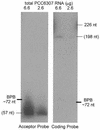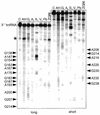Two-piece tmRNA in cyanobacteria and its structural analysis
- PMID: 11972341
- PMCID: PMC113835
- DOI: 10.1093/nar/30.9.2018
Two-piece tmRNA in cyanobacteria and its structural analysis
Abstract
tmRNA acts to rescue stalled bacterial ribosomes while encoding a peptide tag added trans-translationally to the nascent peptide, targeting it for proteolysis. The permuted gene structure found in a group of cyanobacteria is shown to produce a two-piece mature tmRNA, as had been observed previously for the independently permuted gene of alpha-proteobacteria. The pieces have been mapped onto the gene sequence and aligned for the permuted cyanobacterial tmRNA sequences, including four novel sequences. Structural probing and base pair co-variations support a secondary structure model in which two pairings in the tRNA-like domain hold the two pieces together, and the coding piece bearing the tag reading frame additionally contains a single transient pseudoknot and three other stem-loops. This represents a dramatic reduction in pseudoknot number from the five present in one-piece cyanobacterial tmRNA.
Figures







References
-
- Karzai A.W., Roche,E.D. and Sauer,R.T. (2000) The SsrA-SmpB system for protein tagging, directed degradation and ribosome rescue. Nature Struct. Biol., 7, 449–455. - PubMed
-
- Gillet R. and Felden,B. (2001) Emerging views on tmRNA mediated protein tagging and ribosome rescue. Mol. Microbiol., 42, 879–885. - PubMed
Publication types
MeSH terms
Substances
Associated data
- Actions
- Actions

